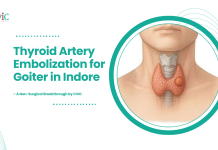Introduction
In recent years, the field of medicine has witnessed remarkable advancements that have revolutionized the way we diagnose and treat various health conditions. One such groundbreaking innovation is Image-Guided Therapies (IGTs). Indore, a bustling city in central India, has embraced these cutting-edge technologies to enhance patient care and outcomes. This blog will explore the world of Image-Guided Therapies in Indore, shedding light on their significance, applications, and the impact they have on the local healthcare landscape.
Understanding Image-Guided Therapies
Image-Guided Therapies refer to medical procedures that use real-time imaging technologies to guide and monitor the progress of minimally invasive interventions. These interventions can range from diagnostic procedures to therapeutic treatments, providing precision and accuracy that traditional methods may lack. The core idea behind IGTs is to enable healthcare professionals to visualize internal structures, target specific areas, and deliver treatment with enhanced control and safety.
The Role of Imaging Modalities in Indore
Indore, like many other modern cities, has witnessed a rapid integration of various imaging modalities into healthcare practices. These modalities include:
Computed Tomography (CT): CT scans use X-rays to create detailed cross-sectional images of the body. In Indore, CT scans play a crucial role in diagnosing conditions such as tumors, infections, and fractures. Moreover, they are an integral part of planning and guiding interventions.
Magnetic Resonance Imaging (MRI): MRI employs strong magnetic fields and radio waves to generate detailed images of soft tissues. In Indore, MRI is commonly used to assess conditions affecting the brain, joints, and internal organs. Its superior soft tissue contrast makes it an invaluable tool for IGTs.
Ultrasound: This non-invasive imaging technique uses sound waves to create real-time images of the body’s internal structures. In Indore, ultrasound is widely used for guiding interventions in areas such as the abdomen, pelvis, and vascular system.
Fluoroscopy: Fluoroscopy involves real-time X-ray imaging, allowing healthcare professionals in Indore to visualize moving internal structures. It is commonly used during minimally invasive procedures like angiography and orthopedic interventions.
Applications of Image-Guided Therapies in Indore
Image-Guided Therapies have found applications across various medical specialties in Indore, transforming the way diseases are diagnosed and treated. Some key areas of application include:
Oncology: IGTs play a pivotal role in the diagnosis and treatment of cancer in Indore. Procedures such as image-guided biopsies, radiofrequency ablation, and brachytherapy rely on precise imaging for targeting tumors and minimizing damage to surrounding healthy tissues.
Interventional Radiology: In Indore, interventional radiologists use IGTs for a wide range of procedures, including angiography, embolization, and stent placement. These interventions are often minimally invasive, reducing patient discomfort and recovery time.
Cardiology: Image-Guided Therapies are extensively used in cardiology for procedures such as angioplasty, stent placement, and cardiac ablation. The real-time visualization provided by imaging modalities enhances the accuracy of these interventions.
Neurosurgery: In Indore, neurosurgeons rely on IGTs for precise navigation during brain and spine surgeries. The ability to visualize critical structures in real-time improves the safety and effectiveness of these procedures.
Benefits of Image-Guided Therapies in Indore
The adoption of Image-Guided Therapies in Indore has brought about numerous benefits for both healthcare providers and patients. Some notable advantages include:
Precision and Accuracy: IGTs enable healthcare professionals in Indore to target specific areas with unparalleled precision. This precision minimizes damage to healthy tissues and organs, enhancing the overall safety and efficacy of medical interventions.
Minimally Invasive Procedures: Many image-guided interventions are minimally invasive, meaning they require smaller incisions or no incisions at all. This results in reduced pain, faster recovery times, and shorter hospital stays for patients in Indore.
Real-Time Monitoring: The ability to visualize internal structures in real time allows healthcare providers in Indore to monitor the progress of interventions as they happen. This real-time feedback enhances decision-making and improves outcomes.
Reduced Complications: With the increased accuracy provided by IGTs, the risk of complications during procedures is significantly reduced. This is particularly important in delicate surgeries or interventions involving critical structures.
Challenges and Future Prospects
While Image-Guided Therapies have undoubtedly transformed healthcare in Indore, there are challenges that need to be addressed to maximize their potential. These challenges include:
Cost: The initial setup and maintenance costs of advanced imaging equipment can be significant. In Indore, efforts are needed to make these technologies more accessible to a broader population, ensuring that the benefits of IGTs reach all segments of society.
Training and Education: The effective use of IGTs requires specialized training for healthcare professionals. Ongoing education and training programs in Indore are essential to ensure that medical practitioners stay abreast of the latest developments in this rapidly evolving field.
Infrastructure: Adequate infrastructure is crucial for the seamless integration of Image-Guided Therapies into the healthcare system in Indore. This includes not only the availability of advanced imaging equipment but also a robust information technology infrastructure for data management and communication.
Looking ahead, the future of Image-Guided Therapies in Indore appears promising. Advancements in technology, ongoing research, and increased awareness are likely to drive further innovation and overcome current challenges. As the healthcare landscape continues to evolve, Indore stands at the forefront of embracing these transformative technologies, paving the way for a healthier and more advanced future.
Our Doctors
Dedicated IR Center for Vascular Problems in Madhya Pradesh
DR. SHAILESH GUPTA
MD, PDCC (INTERVENTIONAL RADIOLOGY) Consultant & Co-Director CVIC (Center Of Vascular & Interventional Care)
DR. ALOK KUMAR UDIYA
MD Radiology, PDCC (Neurointervention Radiology), PDCC ( HPB Intervention Radiology) FINR (Switzerland) & EBIR
Endovascular Surgeon & Consultant Interventional Neuroradiologist at Care CHL Hospital, Indore Co-director CVIC( center for vascular and interventional care)
DR. NISHANT BHARGAVA
Consultant Intervention Radiologist
MD Radiology, PDCC ( Neurointervention Radiology), FINR ( Fellowship in Neurointervention Radiology)
Co-director CVIC(Center for Vascular and Interventional Care)
Contact Details
Phone no.
0731 4675670
+91 9827760073
Facebook
https://www.facebook.com/profile.php?id=100092538633553&mibextid=ZbWKwL
Instagram
https://instagram.com/cvic_center?igshid=ZGUzMzM3NWJiOQ==
Google My business
https://g.co/kgs/DrdV3T
YouTube
https://www.youtube.com/channel/UCP5TH5e4iQZkpDUgnLsgZhw
Pinterest
https://pin.it/5DzpX5Z
Twitter
https://x.com/cviccenter?t=01TclSrLFdu0K2re0Gs96w&s=08
LINKEDIN
https://www.linkedin.com/company/center-of-vascular-interventional-care/
Location –
Read More –
Minimally Invasive Procedures in Indore – https://cvicvascular.com/minimally-invasive-procedures-in-indore/
Radiological Interventions in Indore – https://cvicvascular.com/radiological-interventions-in-indore/
Vascular Imaging Services Indore – https://cvicvascular.com/vascular-imaging-services-indore/




